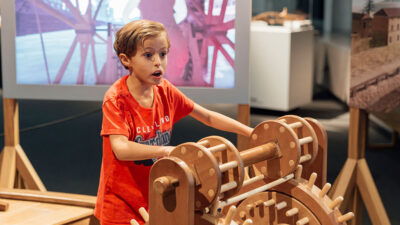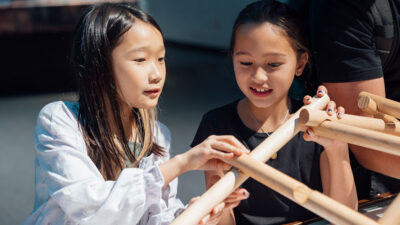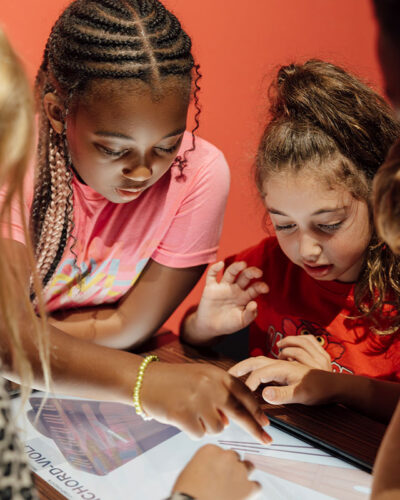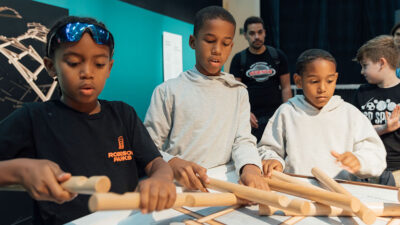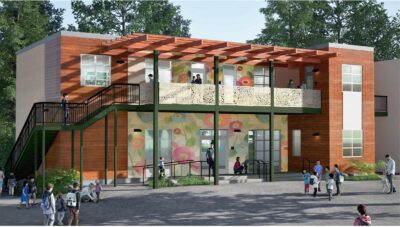This fall, Oakwood’s 3rd-grade students visited LEONARDO DA VINCI: Inventor. Artist. Dreamer, at the California Science Center. This exhibition transported students into a world of wonder and ingenuity, helping them connect to their studies of simple machines and sparking excitement for exploration, experimentation, and hands-on learning.
Principal Denise Ross suggested the field trip after being inspired by the show’s visualization of Da Vinci’s creative process, feeling it was a perfect opportunity for students to experience the inventor’s many ideas up close. “What children need is the ability to think beyond the regular school curriculum—to follow their passions, explore freely, marvel, and dabble in different areas,” Denise shares.
The exhibition showcases thirty of Da Vinci’s inventions—including the Flying Bicycle, Great Organ, Mechanical Bat, and Great Kite—and digitally restored reproductions of his iconic artworks. Denise notes that each display includes information detailing the probability of the inventions’ success, a reminder that “even Da Vinci’s ideas sometimes—oftentimes—failed.” This sends an important message: setbacks are not failures but valuable opportunities for growth and creative problem-solving.
This mindset aligns with Oakwood’s vision for the future Da Vinci Lab—an innovative space at the elementary school designed for exploration, creativity, and imagination. In this dynamic setting, students will be immersed in a world of discovery. “The goal is to connect students with Leonardo da Vinci because of the principles and processes he used to become the polymath that he was. We want to empower them to effect change in their world.” Planning and fundraising efforts are currently underway to bring this exciting vision to life.
Oakwood Technology Instructor and Explorations Coordinator Shane Finch accompanied students on the field trip and shared this: “When you think about Leonardo da Vinci, you might picture his famous paintings, but he was also a visionary inventor. Many of his designs were never built, and those that were, often failed,” Shane explains. “It’s more about the journey than the destination. Sometimes, the things we’re trying to do in class might not go as planned. I’ll ask the kids, ‘If you worked hard on this and it doesn’t work, did you waste your time?’ They come to realize that, no, it’s not a waste. We’re still learning, still trying. The knowledge can be applied to the next project.”
Shane incorporates many hands-on projects into his curriculum. These are designed to encourage creative problem-solving, collaboration, and confidence-building. One example is the 2nd-grade Space Boots project. “We start with a true story about an astronaut who nearly drowned in space due to a malfunction in his suit,’ Shane explains. ‘From there, we brainstorm what we’d need to build something resistant.’”
Students pair up to build waterproof space boots using materials like foil, plastic, scissors, and tape. According to Shane, it’s a tough challenge, with only about half of the boots passing the water-resistance test. “I give them a ton of supplies, but it’s their job to figure it out—work through challenges, make decisions, and problem-solve. They are so invested, and it can be difficult when their designs don’t work,” he says. Shane highlights this as an ideal opportunity for growth. “We reflect afterward—what worked, what didn’t, and what could be done differently. Every group, successful or not, walks away with valuable insights.”
A variety of projects Shane carries out with students in all elementary grades highlight this interdisciplinary approach, including woodworking creations, Halloween fair booths, and a green-screened PSA. This year, he plans to introduce a lighthouse-building project for 3rd-grade students where they will use sustainable materials and a “Makey Makey” device to create a functional circuit that powers a real light. “The students will use clamps, safe saws, and other tools to engineer their lighthouses—tools they will continue to work with in upper grades as they take on increasingly complex projects,’ Shane explains. ‘Over time, this hands-on experience helps them build confidence and familiarity with the tools. This project also connects to their studies of electricity and circuitry.” Shane emphasizes the lasting impact of learning as students bring their ideas to life.
The 3rd-grade trip to LEONARDO DA VINCI: Inventor. Artist. Dreamer reinforced the vital role of resilience in education and learning. “The most significant takeaway from the exhibit,” Shane shares, “was that the process is equally, if not more important, than the final product.”
Denise emphasizes the value of connecting students with Leonardo da Vinci and other transformative figures throughout history. “We want to inspire students with Da Vinci’s principles and processes—his insatiable quest for knowledge, observations, drawings, and integration of disciplines like architecture, nature, math, science, and art. Da Vinci was the original pioneer of STEAM. That’s why we call it the Da Vinci Lab—it’s about encouraging students to follow his lead.”


